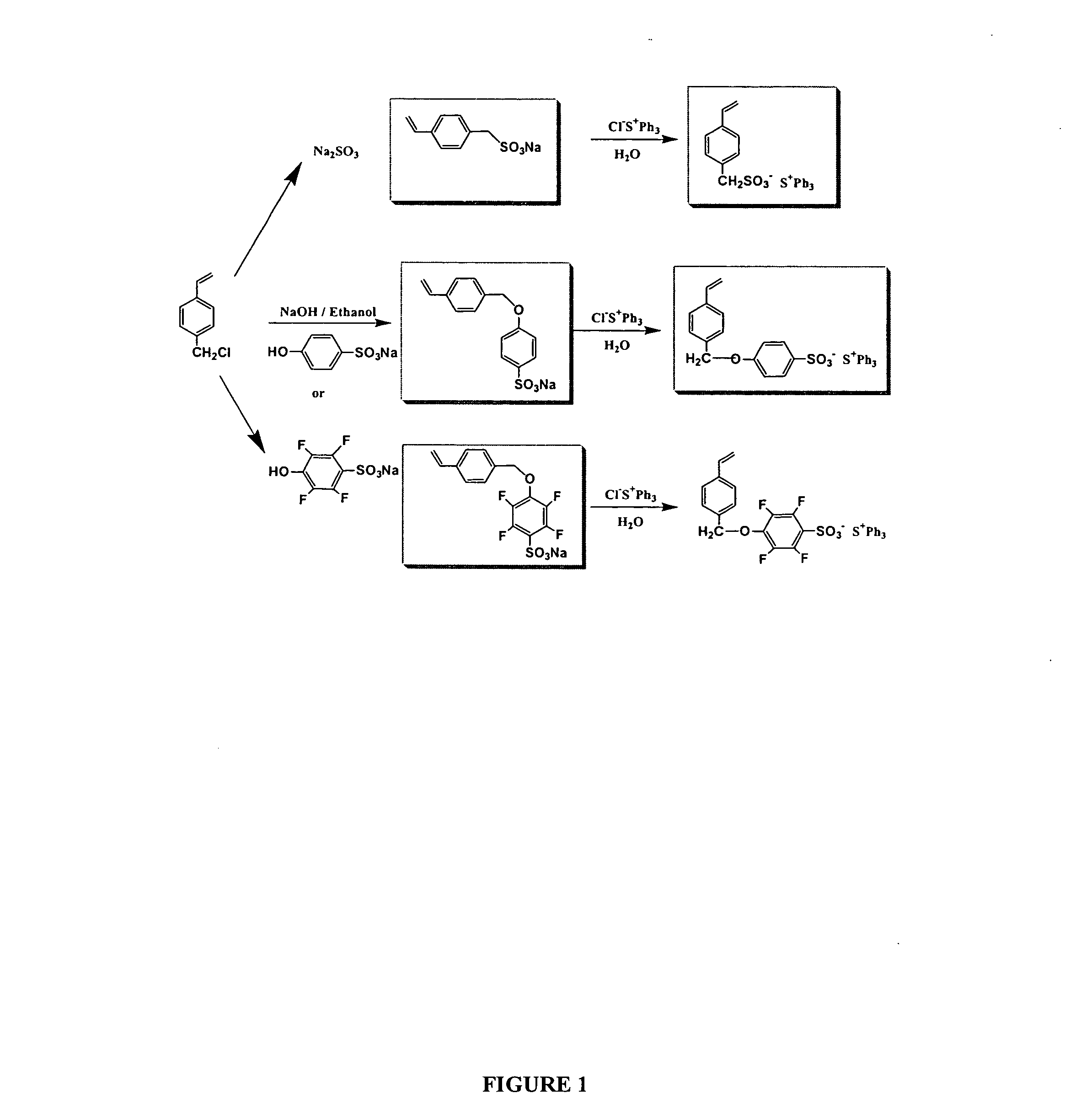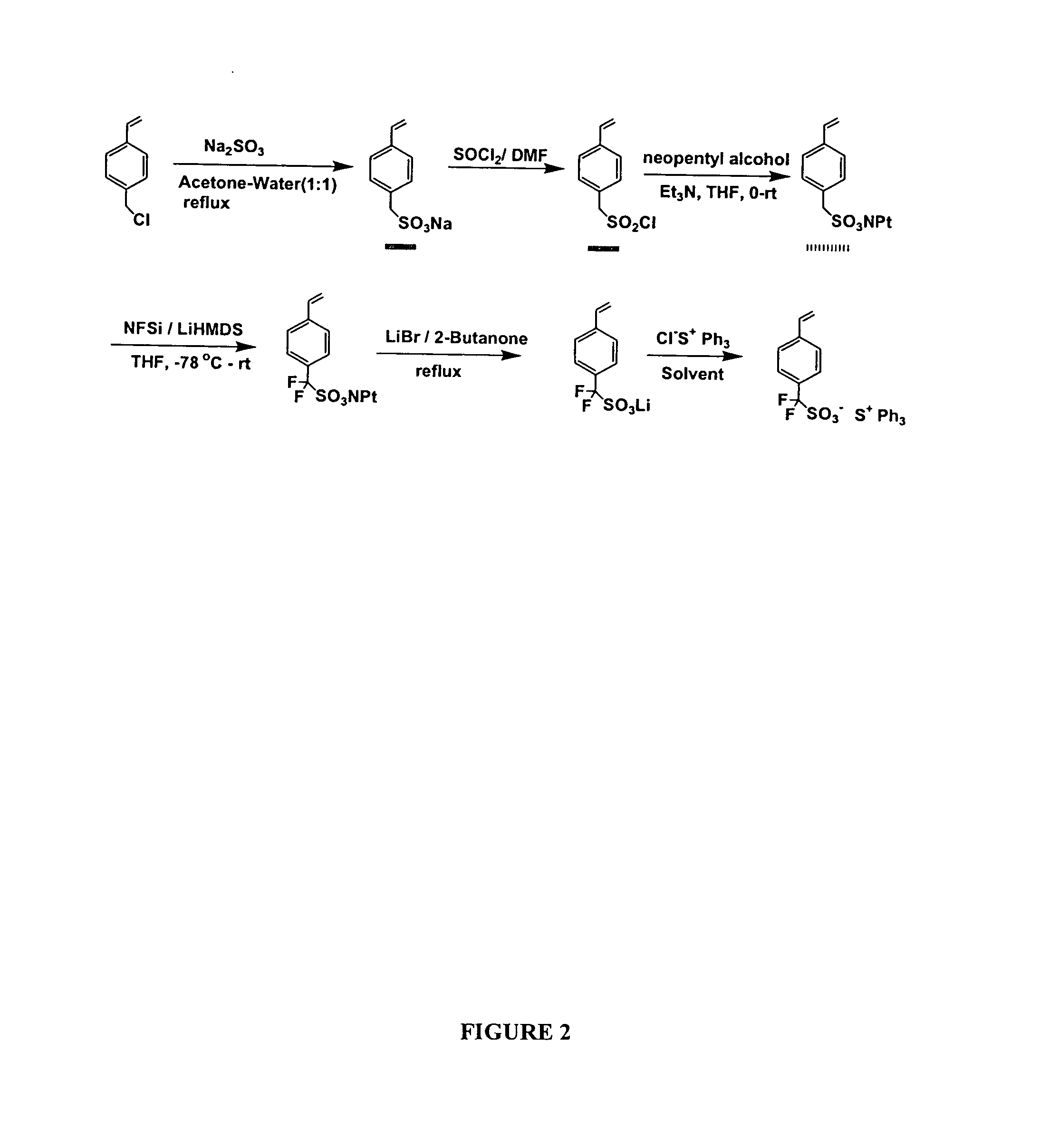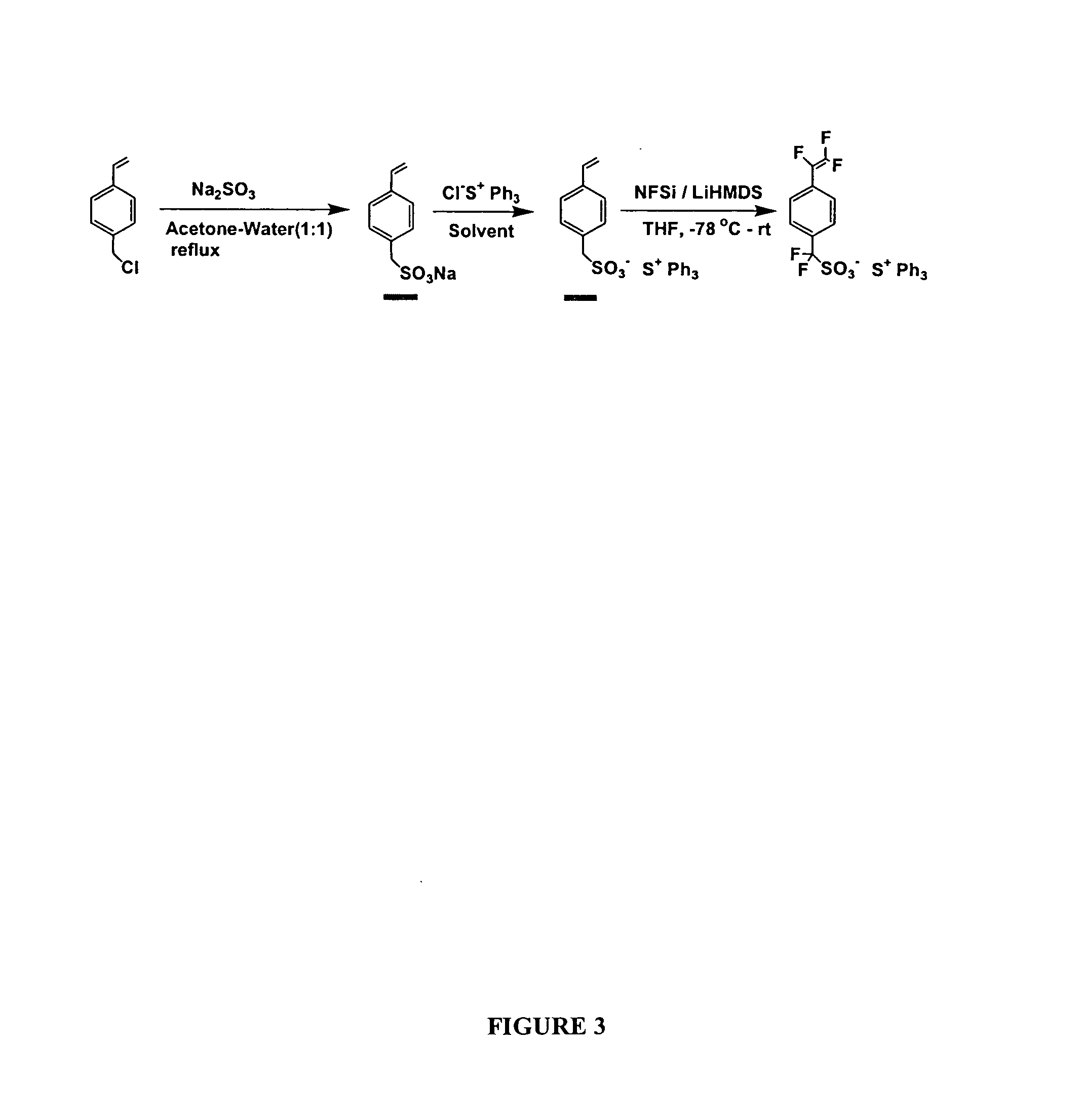Photoacid generators and lithographic resists comprising the same
a technology of photoacid generators and lithographic resists, applied in the direction of photosensitive materials, instruments, photomechanical equipment, etc., can solve the problems of phase separation, non-uniform acid distribution, and small molecule pags that exhibit limited compatibility with resist polymer matrix, etc., to achieve high sensitivity, high contrast, and high resolution
- Summary
- Abstract
- Description
- Claims
- Application Information
AI Technical Summary
Benefits of technology
Problems solved by technology
Method used
Image
Examples
example 1
Synthesis of Triphenylsulfonium salt 4-vinylbenzylsulfonate (VBzS-TPS)
[0150] P-chloromethylstyrene (20 mmol) in 10 ml acetone was added dropwise to the aqueous solution of sodium sulfite (25 mmol) under nitrogen at reflux, and the mixture was refluxed for 12 hours. After cooling to room temperature, the solid was filtered and washed with water, acetone, and dried under high vacuum overnight to give pure product sodium salt, 4-vinyl benzylsulfonate (F4-VBzS-Na) as white solid in 81% yield. characterized by 1H NMR (25° C., ppm) δ7.34 (d, J=9.1 Hz, 2H); 7.26 (d, J=9.1 Hz, 2H); 6.72 (dd, J=10.7 and 18.6 Hz, 1H); 5.79 (d, J=18.6 Hz, 1H); 5.20 (d, J=10.7 Hz, 3H); 3.68 (s, 3H). Then the (VBzS-Na) was reacted with triphenylsulfonium chloride 50% aqueous solution in water, at room temperature overnight. The product was refined with dichloromethane and hexane, Triphenylsulfonium salt 4-vinylbenzylsulfonate (VBzS-TPS) was obtained in 90% yield as a colorless crystal. 1H NMR (25° C., ppm) δ7.4...
example 2
Synthesis of Triphenylsulfonium salt 4-(vinyl benzyloxy) benzenesulfonate (VBzBS-TPS)
[0151] P-chloromethylstyrene (20 mmol) in 10 ml acetone was added dropwise to the aqueous solution of sodium 4-hydroxy-2.3.5.6-tetrafluoro benzenesulfonate (25 mmol) under nitrogen at reflux, and the mixture was refluxed for 12 hours. After cooling to room temperature, the solid was filtered and washed with acetone, and dried under high vacuum overnight to give pure product sodium salt, 4-(vinyl benzyloxy) benzenesulfonate (VBzBS-Na) as white solid in 76% yield. characterized by 1H NMR (25° C., ppm) δ7.46-7.54 (m, 4H); 7.41 (d, J=9.0 Hz, 2H); 6.93 (d, J=9.3 Hz, 2H); 6.72 (dd, J=11.0 and 18.4 Hz, 1H); 5.83 (d, J=18.4 Hz, 1H); 5.27 (d, J=11.0 Hz, 1H); 5.1 (s, 2H). Then the (VBzBS-Na) was reacted with triphenylsulfonium chloride 50% aqueous solution in water, at room temperature overnight. The product was refined with dichloromethane and hexane, triphenylsulfonium salt 4-(vinyl benzyloxy) benzenesulfo...
example 3
Synthesis of Triphenylsulfonium salt 4-(vinyl benzyloxy) 2,3,5,6-tetrafluoro benzenesulfonate (F4-VBzBS-TPS)
[0152] P-chloromethylstyrene (20 mmol) in 10 ml acetone was added dropwise to the aqueous solution of sodium 4-hydroxy-2.3.5.6-tetrafluoro benzenesulfonate (25 mmol) under nitrogen at reflux, and the mixture was refluxed for 12 hours. After cooling to room temperature, the solid was filtered and washed with water and acetone, and dried under high vacuum overnight to give pure product sodium salt, 4-(vinyl benzyloxy) 2.3.5.6-tetrafluoro benzenesulfonate (F4-VBzBS-Na) as white solid in 79% yield. characterized by 1H NMR (25° C., ppm) δ7.49 (d, J=8.1 Hz, 2H); 7.41 (d, J=8.1 Hz, 2H); 6.72 (dd, J=11.2 and 17.8 Hz, 1H); 5.85 (d, J=17.8 Hz, 1H); 5.26 (d, s J=11.2 Hz, 3H), 19F NMR (25° C., ppm, ext.CF3COOH): δ−152.15 (m, 2F); −137.45 (m, 2F). Then the (F4-VBzBS-Na) was reacted with triphenylsulfonium chloride 50% aqueous solution in water, at room temperature overnight. The product w...
PUM
| Property | Measurement | Unit |
|---|---|---|
| wavelength | aaaaa | aaaaa |
| wavelength | aaaaa | aaaaa |
| mol % | aaaaa | aaaaa |
Abstract
Description
Claims
Application Information
 Login to View More
Login to View More - R&D
- Intellectual Property
- Life Sciences
- Materials
- Tech Scout
- Unparalleled Data Quality
- Higher Quality Content
- 60% Fewer Hallucinations
Browse by: Latest US Patents, China's latest patents, Technical Efficacy Thesaurus, Application Domain, Technology Topic, Popular Technical Reports.
© 2025 PatSnap. All rights reserved.Legal|Privacy policy|Modern Slavery Act Transparency Statement|Sitemap|About US| Contact US: help@patsnap.com



